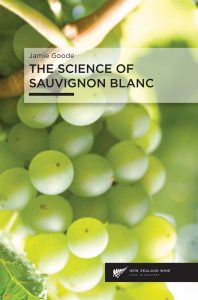The science of sauvignon blanc, by Jamie Goode
| Title of book: | The science of sauvignon blanc |
| Author: | Jamie Goode |
| Publisher: | Flavour Press |
| Publication date: | 2012 |
| ISBN | 978-0-9553035-2-4 |
| Pages: | 133 |
| Price: | £15.00 |
 It’s no surprise that the New Zealand wine industry would publish a book on sauvignon blanc. Benchmark sauvignon blanc arguably became New Zealand’s domain some years ago, and the variety occupies nearly 60% of the total vineyard area of that country. Its dominance is huge. The next most important cultivar (pinot noir, as it happens) has a quarter of the plantings of sauvignon blanc.
It’s no surprise that the New Zealand wine industry would publish a book on sauvignon blanc. Benchmark sauvignon blanc arguably became New Zealand’s domain some years ago, and the variety occupies nearly 60% of the total vineyard area of that country. Its dominance is huge. The next most important cultivar (pinot noir, as it happens) has a quarter of the plantings of sauvignon blanc.
Various research institutes in NZ and France have been researching sauvignon blanc for some years, and Goode has brought together some of that research in a book that aims to provide growers and winemakers up to date information so they are better equipped to achieve the flavour profiles they’re looking for. There’s some interesting stuff for MW students and the like, too.
In the potted history of NZ sauvignon blanc, I was fascinated to read that 95% of NZ plantings of sauvignon blanc are of a single clone.
The rest of the book focuses on sauvignon blanc flavour and factors influencing those flavours. Goode goes through some of the science projects with quite a degree of hefty science language, which can be tricky to keep pace with at times, though he does well to repeat certain things, which saves on lots of little post-it stickies being used for the original reference points (tho’ they’re useful too). For example, if I’ve got it right, it seems Marlborough sauvignon blanc has no unique flavour compounds (compared to sauvignon blancs from elsewhere), but polyfunctional thiols are particularly high in Marlborough sauvignon blanc (box tree, passionfruit and tropical fruit to most of us), and may be part of the region’s unique style.
However incorporating sulphur into carbon backbones to arrive at thiol precursors had me grappling with a few too many acronyms and chemical terms. No matter it seems, the point of this is a possible link of the thiol precursors to something – damage to grapes or leaves is suggested – that’s going on in the vineyard, so the outcome is to suggest different cultural practices. The other viticultural stuff was a bit easier to get to grips with, and the hope that soils are a key influence of sauvignon blanc flavour would indeed give Marlborough a unique place.
The bottom line is if you’re into the dense chemistry, this book’ll be a doddle for you. If you’re not, then you can essentially read the project introduction and conclusion paragraphs and still have some idea of research being done into sauvignon blanc. And the second half of the book is more approachable. The chapter on yeast gave a different angle on the early chemistry, and brought esters into focus, high levels of which are also characteristic of NZ sauvignon blanc.
It’s certainly not a book for the casual oenophile, unless you’re really techy. There was generally more chemistry than I needed, but then not enough of some of the simpler stuff, such as what all the esters smell of. And there are fewer attributions than I might have imagined for a book with ‘science’ in the title. I would have found it useful to have a consolidated reference list at the end, rather than having to backtrack through various footnotes. Undoubtedly some great research projects in here though.



